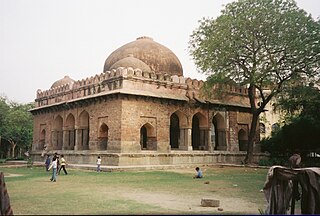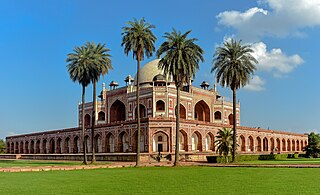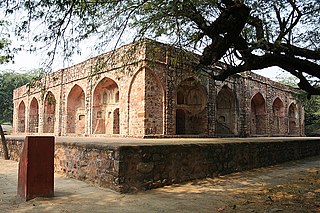
Humayun's tomb is the tomb of Mughal emperor, Mirza Nasir al-Din Muhammad commonly known as Humayun situated in Delhi, India. The tomb was commissioned by Humayun's first wife and chief consort, Empress Bega Begum under her patronage in 1558, and designed by Mirak Mirza Ghiyas and his son, Sayyid Muhammad, Persian architects chosen by her. It was the first garden-tomb on the Indian subcontinent, and is located in Nizamuddin East, Delhi, close to the Dina-panah Citadel, also known as Purana Qila, that Humayun found in 1538. It was also the first structure to use red sandstone at such a scale. The tomb was declared a UNESCO World Heritage Site in 1993, and since then has undergone extensive restoration work, which is complete. Besides the main tomb enclosure of Humayun, several smaller monuments dot the pathway leading up to it, from the main entrance in the West, including one that even pre-dates the main tomb itself, by twenty years; it is the tomb complex of Isa Khan Niazi, an Afghan noble in Sher Shah Suri's court of the Suri dynasty, who fought against the Mughals, constructed in 1547 CE.

Lodi Gardens is a city park situated in New Delhi, India. Spread over 90 acres (360,000 m2), it contains Mohammed Shah's Tomb, the Tomb of Sikandar Lodi, the Shisha Gumbad and the Bara Gumbad, architectural works of the 15th century by Lodis - who ruled parts of northern India and Punjab and Khyber Pakhtunkhwa province of modern-day Pakistan, from 1451 to 1526 are present here. The site is now protected by the Archaeological Survey of India (ASI).

Khanzada Mirza Khan Abdul Rahim, popularly known as simply Rahim and titled Khan-i-Khanan, was a poet who lived in India during the rule of Mughal emperor Akbar, who was Rahim's mentor. He was one of the nine important ministers (dewan) in Akbar's court, known as the Navaratnas. Rahim was known for his Hindustani dohe (couplets) and his books on astrology.

Hazrat Nizamuddin Dargah is the dargah (mausoleum) of the Sufi saint Khwaja Nizamuddin Auliya. Situated in the Nizamuddin West area of Delhi, the dargah is visited by thousands of pilgrims every week. The site is also known for its evening qawwali devotional music sessions.
The Aga Khan Trust for Culture (AKTC) is an agency of the Aga Khan Development Network (AKDN), a family of institutions created by Aga Khan IV with distinct but complementary mandates to improve the welfare and prospects of people in the developing world, particularly in Asia and Africa. It focuses on the revitalization of communities in the Muslim world—physical, social, cultural, and economic. The AKTC was founded in 1988 and is registered in Geneva, Switzerland, as a private non-denominational philanthropic foundation.

Salimgarh Fort was built in 1546 AD, in Delhi, in a former island of the Yamuna River, by Salim Shah Suri, son of Sher Shah Suri. There was a pause in Mughal rule when in 1540 AD Sher Shah Suri defeated the Mughal emperor Humayun and established the Sur dynasty rule in Delhi. Sur dynasty rule lasted till 1555 AD when Humayun regained his kingdom by defeating Sikander Suri, the last ruler of the dynasty. During the Mughal period, in later years, while building the Red Fort and Shahjahanbad, several Mughal rulers reigned, including Emperor Shahjahan, who is credited with completing Shahjahanabad in 1639 AD had camped at the fort. It is said that Humayun had camped at the fort for three days before launching his successful attack for recapturing Delhi.
Nizamuddin West is an upscale residential locality, conveniently located south of India gate. It is a historically busy neighbourhood in Central Delhi and has many parks and trees. It sits in the green lung of delhi, with Humayun's Tomb, Sunder Nursery and Delhi Golf club around it. The popular landmarks around it are Khan Market, Lodi Garden, Oberoi Hotel. It is well connected with Public transport.

Chausath Khamba, also spelled Chaunsath Khamba, is a tomb built during 1623–24. It is located in Nizamuddin precincts of Sufi Muslim shrines and tombs in New Delhi, India. The name means "64 pillars" in Urdu and Hindi. It was built by Mirza Aziz Koka, son of Ataga Khan, as a mausoleum for himself, at the time when Mughal Emperor Jahangir ruled from Delhi. Mirza Aziz Koka had served several times as Jahangir’s Governor of Gujarat before he died in Gujarat.

Barakhamba, also known as Barakhamba Monument, is a 14th-century tomb building from the Tughlaq period that is located in New Delhi, India. Barakhamba means '12 Pillars' in Urdu and Hindi languages. The name has also been used for an upscale modern metro road named the "Barakhamba road" in Connaught Place at the heart of the city.

Jamali Kamali Mosque and Tomb, located in the Archaeological Village complex in Mehrauli, Delhi, India, comprise two monuments adjacent to each other; one is the mosque and the other is the tomb of Jamali and Kamali. Their names are tagged together as "Jamali Kamali" for the mosque as well as the tomb since they are buried adjacent to each other. The mosque and the tomb were constructed in 1528-1529, and Jamali was buried in the tomb after his death in 1535.
Mirza Jahangir was the son of Prince Mirza Jahan Shah, who became the Emperor Akbar Shah II in 1806 and his wife Empress Mumtaz Mahal, he was also the younger brother of Emperor Bahadur Shah II and older brother of Mirza Jahan Shah. Under the pressure of his mother, Mumtaz Begum, Akbar Shah declared him as his successor. However, after he attacked the British resident, Archibald Seton, in the Red Fort, the East India Company exiled him and eventually Bahadur Shah II succeed his father in 1837, to become the last Mughal ruler of India . He was subahdar of Assam from 1813 to 1818. He was the 32nd Mughal ruler in Assam.

Ratish Nanda is a noted Indian conservation architect, who is the Projects Director of Aga Khan Trust for Culture, India.

Sunder Nursery, formerly called Azim Bagh or Bagh-e-Azeem, is a 16th-century heritage park complex adjacent to the Humayun's Tomb, a UNESCO World Heritage Site in Delhi. Originally known as Azim Bagh and built by the Mughals in the 16th century, it lies on the Mughal-era Grand Trunk Road, and is spread over 90 acres. Future plans aim to link nearby areas to develop it into India's largest park covering 900 acres.

Tombs of Battashewala Complex is an Archaeological Survey of India (ASI) protected monument in Nizamuddin East, Delhi. The funerary complex, consists of three Mughal period tombs, known as the Bara Batashewala Mahal, the Chota Batashewala Mahal, an unidentified Mughal tomb and arched compound wall enclosures.

Sabz Burj is an octagonal Mughal-era mausoleum situated at an intersection on Mathura Road, near Nizamuddin complex, west of Humayun's Tomb, Delhi. Constructed in 1530s, it is among the earliest Mughal-era buildings and features rare patterns inspired by Timurid architecture from Central Asia. The identity of its builder and who is buried here is not known. Its ceiling, painted using pure gold and lapis lazuli is considered to be the earliest painted ceiling for any Mughal structure in India with no similar example surviving anywhere else in the world.

The architecture of Telangana dates back over two thousand years. The Indian state of Telangana is in the Deccan plateau, bordering the coastal plain of Andhra Pradesh. It has produced regional variants of wider styles of Indian architecture, both in Hindu temple architecture and Indo-Islamic architecture.

A distinct Indo-Islamic architecture style with local contribution is reflected in the historical buildings of Hyderabad, making it the first and "Best Heritage City of India" as of March 2012. The city houses many famous historical sites constructed during Qutb Shahi and Asaf Jahi period, including various mosques and palaces.

The Haft Gumbaz, also spelt Haft Gumbad are a group of tombs of the Bahmani dynasty situated in Kalaburagi, in the Indian state of Karnataka. Built during the 14th and 15th centuries, the tombs are examples of early Indo-Islamic architecture. There are seven tombs in total, with four being tombs of the rulers of the Bahmani dynasty. The tomb complex is a monument of national importance, maintained by the Archeological Survey of India. The tomb complex is part of the "Monuments and Forts of the Deccan Sultanate", which is an ensemble of various structures added to the tentative list of the UNESCO World Heritage Sites.
















